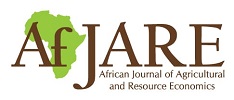Economic analysis of yellow passion fruit production in southeastern Nigeria under different soil fertility management
Okorie Okoro Ndukwe, Chinyere Charity Okeke, & Paul Kayode Baiyeri
Abstract
Three experiments were conducted from 2014 to 2018 to examine the economics of yellow passion fruit production under different soil fertility management. In 2014, two yellow passion fruit genotypes, that is Conventional and KPF 4, were grown in the field and pot simultaneously under varying rates of poultry manure (PM), including 0, 10, 20, 30 and 40 t/ha. In 2016, the response of the two genotypes to a single and combined application of organic and inorganic fertilisers was evaluated under field conditions, namely no fertiliser application, 10, 20 t/ha PM, 400 kg/ha NPK 15:15:15, 5 t/ha PM + 200 kg/ha NPK, and 10 t/ha PM + 200 kg/ha NPK. The profitability indicators were gross revenue, net revenue, returns per naira invested and the profitability index. In 2014, total variable cost increased significantly (P < 0.05) with an increase in PM rates in both the field and pot studies. The highest net returns and returns per naira invested were obtained with the application of 20 t/ha PM. The combined application of 10 t/ha PM + 200 kg/ha NPK recorded the highest gross return, net return and return per naira invested in the 2016 production cycle. Growing the vines without fertiliser application gave significantly least net returns without profit in both production cycles and methods. Consequently, applying 20 t/ha PM was adjudged the most profitable for yellow passion fruit production in the study area, and hence is recommended particularly when organic farming is intended. However, if growers must use inorganic fertiliser, a combined application of 10 t/ha PM + 200 kg/ha NPK will be most profitable.
